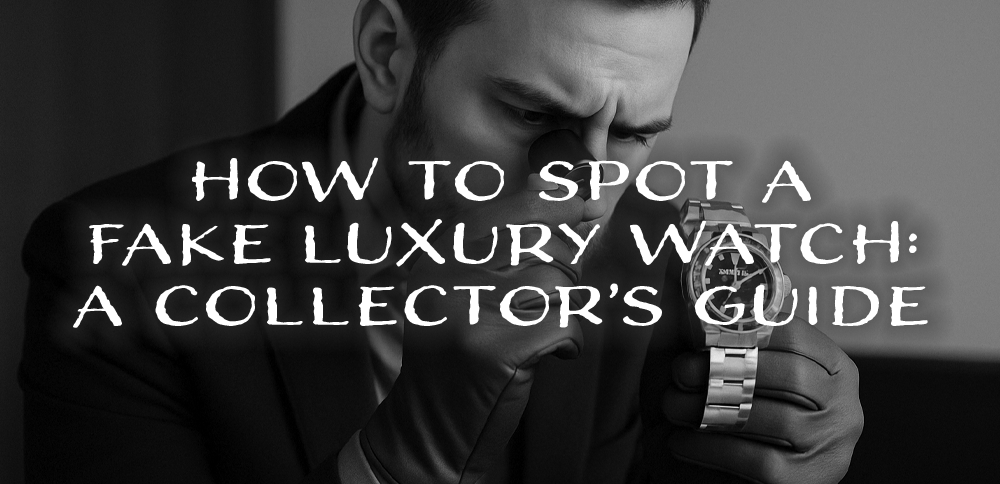How to Spot a Fake Luxury Watch: A Collector’s Guide
In a booming market filled with collectors, investors, and fashion-forward buyers, luxury watches are more than accessories—they’re tangible assets and status symbols. With growing demand for pre-owned luxury watches for sale, counterfeiters have become more sophisticated. If you’re not careful, you could mistake a replica for the real thing and lose thousands.
Whether you’re eyeing a pre-owned Rolex Submariner or a Cartier Santos, here’s how to identify a fake and make a confident, informed purchase.
1. Check the Serial and Model Numbers
Every authentic luxury watch has a unique serial number and model (or reference) number, often engraved in precise, consistent typography. These numbers:
- Match the original paperwork or manufacturer database
- Should be deeply and cleanly engraved—not acid-etched or printed
- Appear in specific locations depending on the brand (e.g., between the lugs or on the rehaut in Rolex watches)
2. Study the Dial and Markings
Luxury brands obsess over design precision. Fakes often miss the mark on:
- Font spacing or alignment
- Logo placement or proportions
- Date window magnification (especially Rolex’s Cyclops lens)
Compare the dial with high-resolution images from the official brand catalog. Any deviation is a red flag.
3. Feel the Weight and Materials
Genuine luxury watches use premium materials like stainless steel, gold, platinum, and sapphire crystal. Authentic watches are heavier and feel more solid than their counterfeit counterparts.
- If it feels hollow, rattly, or cheap—it probably is
- Caseback and bracelet should match the finish and tone of the watch head
4. Inspect the Movement
This is often where fakes are exposed. Luxury watches use intricate mechanical or automatic movements. A few things to look for:
- Sweeping second hand: Not a tick-tick motion (unless it’s a quartz model)
- Decorated movement: Especially in transparent caseback watches like Omega or Grand Seiko
- Reliable brands: Should use in-house or Swiss-made calibers
If in doubt, have a certified watchmaker open the caseback for inspection.
5. Check the Crystal and Cyclops
Luxury watches use sapphire crystal which is extremely scratch-resistant. Run a drop of water on the crystal—on real sapphire it beads tightly; on fake mineral glass it spreads flat.
Rolex’s Cyclops magnifier should zoom 2.5x. Weak or misaligned magnification is common in fakes.
6. Evaluate the Lume
Most luxury sports watches feature high-grade lume. Look for:
- Even glow across the dial and hands
- Quick charging under light
- Brand-specific colors (e.g., Rolex Chromalight glows blue)
7. Scrutinize the Caseback
Many luxury watches use solid casebacks with minimal engraving. Too much branding or unnecessary transparency can be a sign of a fake.
- Rolex: Usually a smooth steel back with no display
- Panerai, Omega: Often have exhibition casebacks—but with proper serials and movement finishing
8. Original Packaging and Papers
While not required, having the original box, papers, warranty card, and even purchase receipts can boost legitimacy. These items:
- Help trace provenance
- Boost resale value
- Make forgery less likely
9. Buy from Reputable Sellers
The most important safeguard is choosing a trusted source. Look for:
- Certified pre-owned dealers
- Established independent jewelers with reviews
- Authentication guarantees
Be wary of deals on marketplaces or social media. If it sounds too good to be true—it probably is.
10. Get a Professional Appraisal
If you’re unsure, have the watch appraised or authenticated by a certified watchmaker or horologist before committing to the purchase. Some sellers even offer third-party authentication on request.
Final Thoughts
Buying a luxury timepiece—especially pre-owned—should be a rewarding experience. But with counterfeiters getting more sophisticated, due diligence is critical.
By examining the details, asking the right questions, and buying from trusted sources, you can confidently enjoy your next luxury watch—and protect your investment.
FAQs
-
What are the easiest ways to tell if a luxury watch is fake?
The biggest red flags are missing or mismatched serial numbers, poor finishing, incorrect logo placement, a ticking second hand (on a mechanical watch), or cheap-feeling materials. -
Can fake watches have real serial numbers?
Yes. Some counterfeiters replicate real serial numbers from genuine watches. Always verify that the number matches the correct model and production year. -
Do real luxury watches tick or sweep?
Most genuine luxury mechanical watches have a smooth sweeping second hand. If it ticks once per second, it may be quartz—or a fake trying to pass as mechanical. -
Are fake watches always easy to spot?
No. Some “super fakes” are very convincing. That’s why it's important to have a watch authenticated if you’re uncertain—even experienced collectors do.


